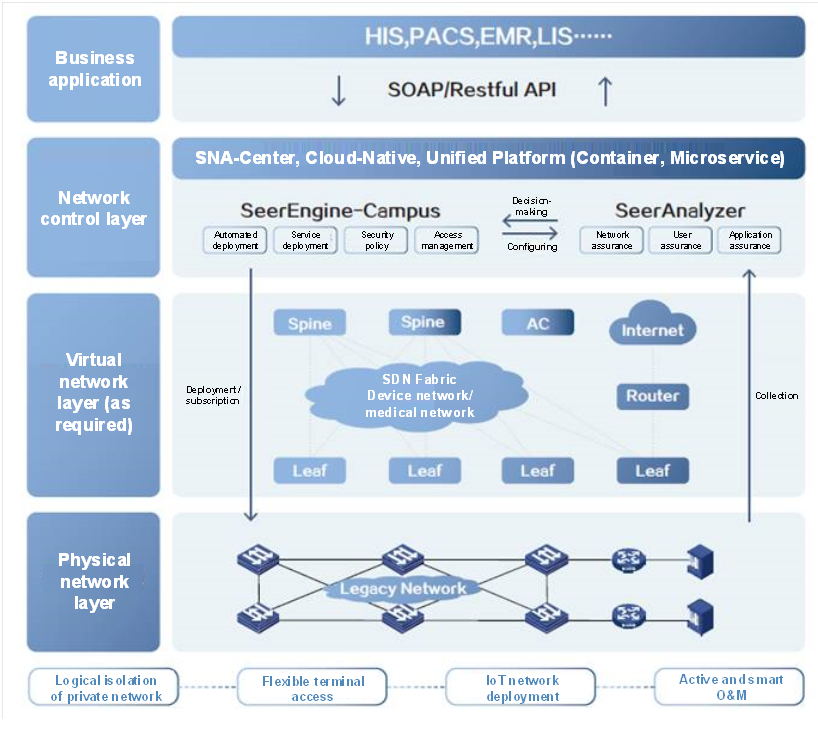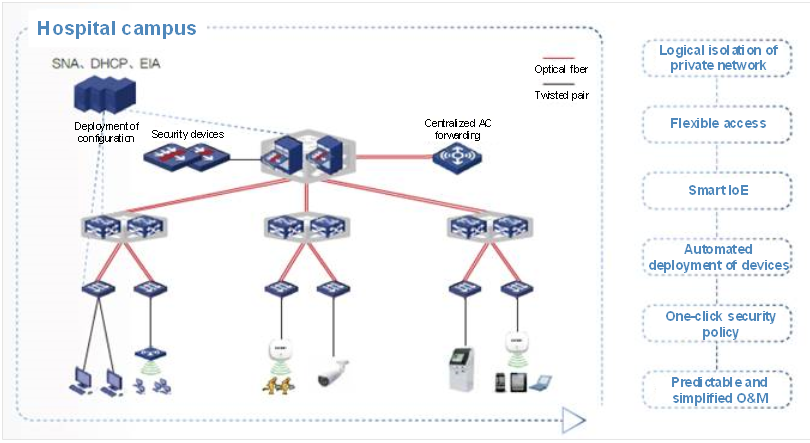Country / Region
Smart Campus Network Solution for Hospitals
I. Background - policies
Smart hospital leads the innovation of smart campus
Since 2014, the Statistics Center of the National Health Commission carries out the standardization and maturity assessment of the national health and medical information interconnection. The assessment is conducted annually and publicized to promote hospital construction. The Statistics Center aims to promote the in-depth construction of the medical information system through maturity assessment, HIMSS certifications, and JCI certifications.
According to the Guiding Opinions on the Construction and Development of Medical Consortiums issued in April 2017, all the primary health care institutions of Grade-II public hospitals will participate in the medical consortium by 2020, to improve the information service ability of the Grade-II hospitals.
In September 2018, the Administrative Measures for National Health and Medical Big Data Standards, Security and Services (Trial) proposed to strengthen medical and health big data services and use the big data in healthcare as a basic national strategic resource. As service data has become increasingly diversified, the underlying information system is required to provide large data platforms with stable and durable support.
The Notice of the Work Plan for Comprehensively Improving the Comprehensive Capability of County-level Hospitals 2018-2020 issued in October 2018 proposed the aim of upgrading some county-level secondary hospitals to tertiary hospitals. The massive increase in the number of beds requires the hospital to expand itself or build new hospital sites, and therefore there is a surge in the number of infrastructure construction projects for information systems.
Functional requirements of smart hospitals
Mobile
Mobile medical care and mobile office have put forward higher requirements for the authority and security management of wireless access users in hospitals.
IoT-based
There are various IoT terminals in the smart campus. Hence, we need to find a way to quickly access these terminals and provide security isolation for services. The terminals need to be able to quickly identify the network and go online.
Complex
The traditional O&M mode is powerless when faced with massive access of patients, medical staff, and management personnel, as well as complex equipment and authority configuration.
II. Background - challenges
Traditional hospital network
Rigid network
The network in the hospital is tightly coupled with the location, the business travel permission of the branch hospital is complicated, and the network has a low automation level.
Information silos
Network resources are scattered, sub-scenarios are independent of each other, and therefore data silos are formed. This results in waste of resources and difficult management.
Terminal risks
The growing type and number of hospital terminals lead to a surge of security risks, and there is an urgent need of improving the network access efficiency.
Complex O&M
It is difficult to locate network faults in the hospital due to poor network visibility and lack of intelligent O&M mechanism.
New hospital network
Network changes as required
The campus network is decoupled from the location, the policy business changes as required, the application service is distributed on demand, and the campus network policy is deployed with one click.
Simplified convergence
The wired and wireless convergence of the hospital's network enables multi-scenario linkage, cross-campus service deployment and scheduling, and network security integration.
IoE
The new campus network enables automated identification, sorting and management of multiple terminals in the hospital, as well as the automated deployment of devices. Besides, it integrates H3C Endpoints Profiling System (EPS) for security management.
Predictable network assurance
The overall network health of the hospital is visualized and the network faults can be quickly located, with proactive and simple O&M.
III. Overview of solution

The H3C smart campus network solution for hospitals introduces the technology of SDN+VXLAN. By constructing a new-generation flexible basic campus network based on VXLAN and related software-defined concepts, it enables interconnection and unified management of multiple hospital branches, secure business isolation, and visualized smart O&M. Functions such as automated deployment of devices and secure access of IoT terminals accelerate the intelligent construction of networks in the hospitals, greatly reduce the complexity of network O&M, and meet the needs of network construction for smart hospitals.
IV. Highlights of solution
Advanced network architecture
Innovative SDN+VXLAN architecture, ensuring network security, service allocation on demand, unified resource management, unified policy deployment, and flexible expansion of network resources.
Whole-process business management
Automated device deployment, automated service deployment, automated fault replacing, and unified cross-campus management enable whole-process management of the campus network of hospitals.
Secure network policies
User security authentication, authority security management, automatic and secure access of massive terminals, as well as logical isolation of internal and external networks ensure safe operation of the campus network.
Intelligent and predictable network assurance
The combination of big data and AI, global protection during, before, and after the event, real-time monitoring of network health, rapid fault location, and visualized O&M make the campus network smarter and easier to operate and maintain.

V. Best practices
Beijing Hospital
Beijing Hospital is a modern comprehensive hospital open to the public, which also provides medical and health services to senior officials. While focusing on geriatrics, it embraces medicine, teaching, scientific research, and disease prevention. As a Grade-III Class-A hospital directly under the National Health and Family Planning Commission of the People's Republic of China, it is an important health care base for official cadres.
H3C helped Beijing Hospital realize the one-key startup of the hospital network and the automated network deployment through the smart campus network solution for hospitals, which greatly shortens the time for hospital services to go online. With the VXLAN technology, the solution helped the hospital build a logic business network so that the whole hospital was covered with networks, meeting the flexible network needs of the customer and simplifying network management and configuration.
At the technical level, this solution enhances the reliability of the core nodes and links of the hospital network, improves the network speed and service quality, and reduces the workload of O&M personnel. It saves users the trouble of going to a low-voltage room for equipment management and configuration.
At the business level, with the increase of Internet-related services in Beijing Hospital, the upgraded network perfectly fits its needs for network acceleration and the construction of flexible network infrastructure, laying a good foundation for its subsequent network transformation in the North District.


